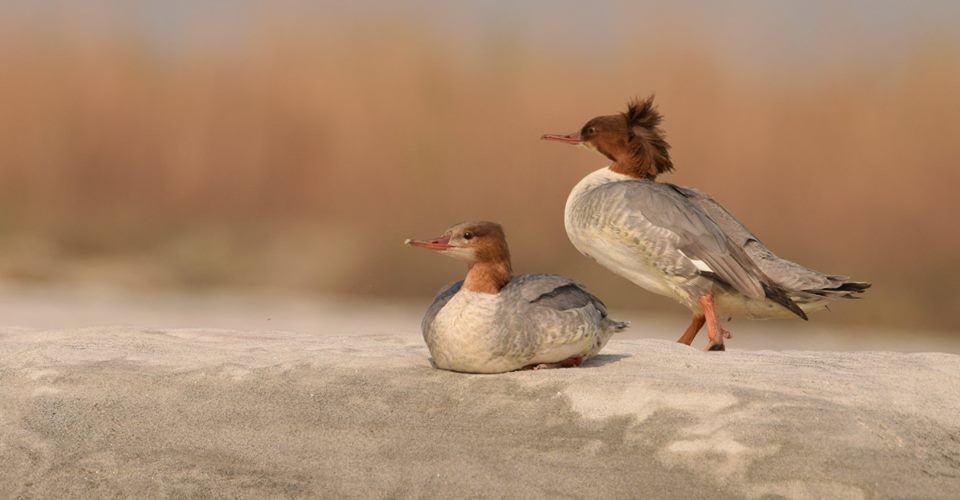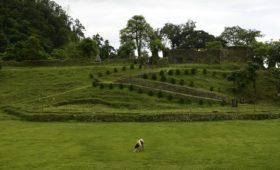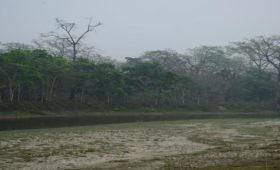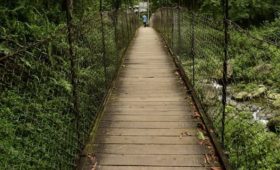From Jalpaiguri, we set for magical wetlands of Gajoldoba in search of migratory birds and waders primarily Common Merganser(Male) – a typical fish-eating duck of Europe and North America. We packed our lunch because the whole day we will be in a boat. Gajoldoba is about 1 hr drive from Jalpaiguri.
It was a sunny morning; our boatman Tapas was ready with his boat. We swiftly passed through the dam to the main river, as Common Merganser can be found upstream nearly 6 km from our starting point.
As Tapas was steering the boat through water-grass locally called “Hogla” into the mainstream, he was quick to spot a Mallard pair in a group of other ducks. Mallard ducks are the most common and recognizable wild ducks in the Northern Hemisphere. The male mallard duck, called a drake, sports a glossy green head, a white ring around its neck and a rich, chestnut-brown breast. The mottled brown female mallard looks downright dull next to the male’s showy feathers.
We steer through the meandering river in the company of cool breeze, birds and waders landing and taking-off, raptors hovering over – a treat for the eyes.
As we cruise along, Tapas steered the boat towards muddy flats – the favourite hunting ground for Common Shellduck. As told by Tapas, this year only one Shellduck pair has migrated to Gajoldoba. Something caught my eyes and I took out my binoculars. Well, it was Shellduck basking under the sun on a muddy flat. Shellducks are residents of western Europe. The Common Shelduck has a goose-like appearance, with a white and chestnut body, dark green head and neck, and a bright red bill.
A flock of Bar-headed geese was swimming at the far end. Bar-headed geese cross across the Himalayas – one of the most iconic high-altitude migrations in the world. Flight of these over Himalayas and Tibet where less than 10% of oxygen is available in comparison to sea level has fascinated and pondered biologists over decades. Bar-headed geese is a large bird but get well camouflaged with the backdrop of sandy beaches.
We steer further in our quest for Common Merganser. Suddenly a Merganser(female) flew past us from nowhere. Common Merganser is a fish-eating duck that rides low in the water on freshwater lakes and rivers. In migration and winter, they mix with other fish-eating, diving ducks such as Bufflehead, goldeneyes, and other species of mergansers. These waders are common residents of Gajoldoba Wetland every year during winters. We saw a flock of merganser all around. Our frantic search for Merganser(Male) did not yield desired results and we decided to return. Uncertainty, patience, luck and of course your boat-man makes birding so exciting.
We decided to halt for a while on one of the sand beaches and had our lunch. As we steer towards the coast, we saw a Northern Lapwing on mud silt, in search of invertebrates such as earthworms and insects. Arguably the most beautiful bird of Gajoldoba.
Our weary body long for nothing but – Bed. It’s time to call it a day. May this was our last trip for this winters to Gajoldoba. With Happy Souls – we board down from the boat.
Birds of Gajoldoba:
Mallard, Common Shellduck, Ruddy Shellduck, Common Merganser, Bar-headed Geese, Northern Lapwing, River Lapwing, Red Crested Pochard.
Spotlights
How to reach Gajoldoba: Nearest rail station is NJP. Gajoldoba is about 30 minutes drive from NJP. The journey from NJP to Gajoldoba is itself a memorable experience. On the left side of the road is the Teesta Canal and on the right is the beautiful Baikunthapur forest. Alternatively, it’s about 1 and ½ hr drive from Bagdogra Airport.
Accommodation: Best accommodation available at Gajoldoba is “Bhorer Alo” – a property of West Bengal Tourism Development Corporation. AC Room with attached toilet/ AC Tent with non-attached toilet is available. To know more about and to book online“Bhorer Alo” click – Online Reservation Bhorer Alo Gajoldoba.
Accommodation is also available at “Boroli” restaurant and few other properties like “Balaji Inn”.
Best time to visit: Nov to Feb
Things to carry: Essential medicine and Binoculars for birding.













